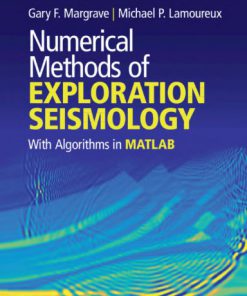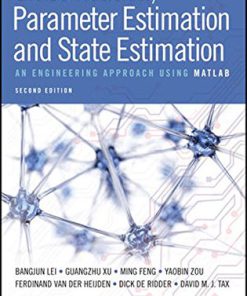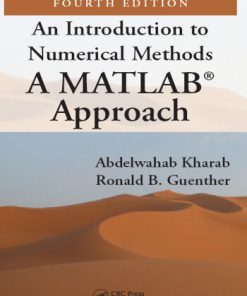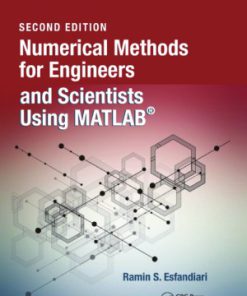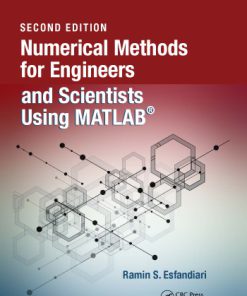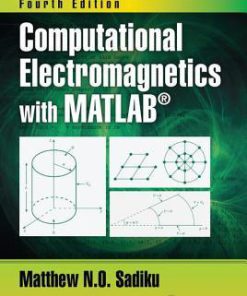Numerical Methods for Engineering An introduction using MATLAB and computational electromagnetics examples 2nd Edition by Karl Warnick 1839530731 9781839530739
$50.00 Original price was: $50.00.$25.00Current price is: $25.00.
Numerical Methods for Engineering An introduction using MATLAB and computational electromagnetics examples 2nd Edition by Karl Warnick – Ebook Instant Download/Delivery ISBN(s): 1839530731, 9781839530739
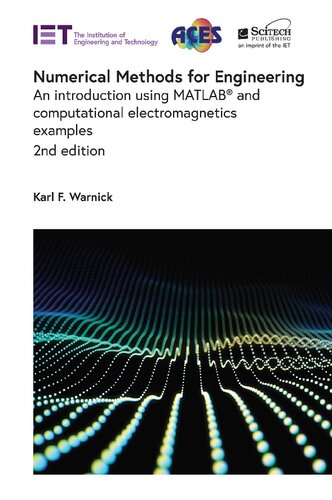
Product details:
- ISBN 10: 1839530731
- ISBN 13: 9781839530739
- Author: Karl Warnick
The revised and updated second edition of this textbook teaches students to create modeling codes used to analyze, design, and optimize structures and systems used in wireless communications, microwave circuits, and other applications of electromagnetic fields and waves. Worked code examples are provided for key algorithms using the MATLAB technical computing language.
The book begins by introducing the field of numerical analysis and providing an overview of the fundamentals of electromagnetic field theory. Further chapters cover basic numerical tasks, finite difference methods, numerical integration, integral equations and the method of moments, solving linear systems, the finite element method, optimization methods, and inverse problems.
Developing and using numerical methods helps students to learn the theory of wave propagation in a concrete, visual, and hands-on way. This book fills the missing space of current textbooks that either lack depth on key topics or treat the topic at a level that is too advanced for undergraduates or first-year graduate students.
Presenting the topic with clear explanations, relevant examples, and problem sets that move from simple algorithms to complex codes with real-world capabilities, this book helps its readers develop the skills required for taking a mathematical prescription for a numerical method and translating it into a working, validated software code, providing a valuable resource for understanding the finite difference method, the method of moments, the finite element method, and other tools used in the RF and wireless industry.
Table of contents:
1 Introduction
1.1 Scientific Computation, Numerical Analysis, and Engineering
1.2 Computational Electromagnetics
1.2.1 Applications of CEM Tools
1.2.2 Types of CEM Methods
1.2.3 Mesh and Grid Generation
1.3 Accuracy and Efficiency
1.4 Programing Languages
1.5 Writing and Debugging Numerical Codes
References
2 Fundamentals of Electromagnetic Field Theory
2.1 Electromagnetic Field and Source Quantities
2.2 Maxwell’s Equations
2.2.1 Constitutive Relations
2.2.2 Impressed and Induced Currents
2.2.3 Magnetic Currents
2.3 Coordinate Systems
2.3.1 Rectangular Coordinates
2.3.2 Cylindrical Coordinates
2.3.3 Spherical Coordinates
2.4 Gradient, Curl, and Divergence
2.5 Laplacian
2.6 Wave Propagation
2.7 Electromagnetic Boundary Conditions
2.8 Time-and Frequency-Domain Representations
2.9 PlaneWaves
2.9.1 Wave Vector
2.9.2 Position Vector
2.9.3 PlaneWave in Vector Notation
2.9.4 Characteristic Impedance
2.10 Propagating, Standing, and EvanescentWaves
2.11 Bessel Functions
2.11.1 Hankel Functions
2.11.2 CylindricalWaves
2.12 Power and Energy
2.13 InitialValue Problems and BoundaryValue Problems
2.13.1 Modes
2.13.2 1-D, 2-D, and 3-D Boundary Value Problems
2.13.2.1 1-D Problems
2.13.2.2 2-D Problems and the Transverse Electric (TE) and Transverse Magnetic (TM) Polarizations
2.13.2.3 3-D Problems
2.13.3 Radiation and Scattering Problems
2.13.4 Inverse Problems
2.13.5 Green’s Functions and Radiation Integrals
2.13.6 Formulating and Solving Boundary Value Problems
2.13.7 The Equivalence Principle
2.14 Other Topics
Problems
References
3 Basic Numerical Tasks
3.1 Introduction to MATLAB Programing
3.1.1 Vectors and Arrays
3.1.1.1 Colon Operator
3.1.1.2 Vector and Array Operations
3.1.2 Working with Plots
3.1.2.1 3-D Plots
3.1.3 Scripts
3.1.3.1 Comments
3.1.3.2 ParameterValues and Plot Commands
3.1.4 Functions
3.1.5 Arguments and Structure Arrays
3.1.6 Speeding Up MATLAB Codes
3.1.7 Other MATLAB Commands
3.2 Numerical Differentiation
3.2.1 Code Example: Central Difference Rule
3.3 Numerical Integration
3.3.1 Code Example: Midpoint Integration Rule
3.4 Interpolation
3.5 Curve Fitting
3.5.1 Code Example: Polynomial Fitting
3.6 Newton’s Method
Problems
References
4 Finite Difference Methods
4.1 Basic Components of Finite Difference Solvers
4.1.1 Grid
4.1.2 Stencil
4.1.3 Boundary Conditions
4.1.4 Sources
4.1.5 Solution Method
4.2 Wave Equation: 1-D FDTD Method
4.2.1 1-D Grid
4.2.2 Update Equation for the 1-DWave Equation
4.2.3 Initial Condition
4.2.4 Boundary Conditions for the 1-D FDTD Method
4.2.4.1 First-Order Mur Absorbing Boundary Condition
4.2.5 Hard and Soft Sources
4.2.6 Source Turn-On Functions
4.2.7 Code Example: 1-D FDTD Algorithm
4.2.7.1 Numerical ResultsWith the 1-D FDTD Code
4.2.8 Stability
4.2.9 Accuracy
4.2.9.1 r =1 Case
4.2.9.2 r
People also search:
international journal for numerical methods in engineering
international journal for numerical methods in biomedical engineering
numerical methods for scientific and engineering computation
numerical methods for scientific and engineering computation pdf
numerical methods for engineers and scientists 3rd edition
You may also like…
Engineering
An introduction to numerical methods : a MATLAB® approach 4th Edition Guenther 9781138093072
Mathematics - Numerical Analysis
Numerical Methods for Engineers and Scientists Using MATLAB® Ramin S. Esfandiari
Science (General)
Mathematics




